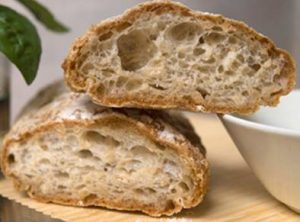When Bread Is An Art Form
FT BeyondBrics: Investors needed for Africa energy gap
31 January, 2014Euromoney Islamic finance awards 2014
1 February, 2014Australian Financial Review Sophisticated Traveller, February 2014
In a restaurant kitchen in Cambridge, a white-haired man with an immaculate beard is describing his focaccia and sourdough breads. One takes six hours to make, he says; the other, four days. “One of my students has a bakery in London, and when he turns his back, his staff are looking for ways to do it easier,” he says. “There isn’t. I’m sorry. You don’t paint a Rembrandt by cutting corners.”
It would be easy to mock the man – if you hadn’t tasted the bread. This is the sort of bread that makes you do odd things with your eyebrows. It’s the sort of bread that makes you shake your head even though your reaction is overwhelmingly positive, and to make involuntary closed-mouth half-chewed groans. It is very good bread.
The man is Carl Shavitz, of the Artisan Bread School, and he takes his bread seriously. But there is, it is increasingly clear, a considerable market for this, and Shavitz runs courses in England, Italy and the United States teaching people how to do it. They are a major undertaking: the courses in Britain, for example, last five days – and five long days, full working days – and are held in a range of beautiful barns in Norfolk, in which the students sleep in the rare moments of the day when they are not making bread, or learning how to do so.
But for a certain type of person – one who has tired of a career of long hours that have involved creating nothing tangible, perhaps – a course like this gives a new lease of life. “I can tell you with all honesty that people have come on the five-day course, and gone off and set up bakeries within a month,” Shavitz says. “They appeal to people who are passionate about doing it, who want to use the best ingredients. I get doctors, lawyers, industrialists.
“You’re not going to make a killing out of it. People have to want to do it. But you get huge satisfaction out of it.”
AFR’s demonstration is a truncated three hour course held in the kitchen of Cambridge’s Cotto restaurant, within whose tiny confines Shavitz is attempting to conduct six rounds of baking almost simultaneously. Boards and covers are piled upon one another, where dough rests between kneads or rehydrations; on a pair of iPads, lines of clocks count down the precise length of time each bread needs before the next stage in its convoluted process of conception.
To the novice, the process is utterly arcane. Within minutes we have been briefed on the world of wild versus commercial yeast, the nature of rye flour, the mechanics of hydration. “There are two kinds of barley malt powder: diastic and non-diastic,” he says. It feels like a crash chemistry degree, and indeed, science is a large part of this, as well as some informed common sense. “Some recipes say mix the water and olive oil together and put it in the flour,” he says, exasperated, while preparing a focaccia mix. “That’s not logical! If you coat any flour with olive oil, how will it absorb any water?” He laughs, incredulous. We laugh too, clueless.
Two things that do shine through instantly are the importance of ingredients and the precision of the whole process. “Use the best ingredients you can afford,” he says; in fact, the process of sourcing the best olive oil, for example, has taken him all over Italy. Then there’s the science of stone-ground rather than roller-ground flour. And his recipes specify the amount of each ingredient down to the individual gram, something he has down to a fine art: needing 514 grams of flour at a particular point in the process, he lops an apparently random couple of handfuls onto the scale. “Ah. 513,” he says. “Sorry.” And swiftly corrects.
Kneading and folding are similarly exact: seven folds towards the centre, use the flats of your fingers; then, later, 25 kneads. “If you knead it more than 25 times, you’ll end up with a car tyre. Do 25.” Shavitz does everything by hand, and ensures the sides of the bowl are always scraped, so as not to lose those precise measurements. “If you don’t, something’s going to dry out and someone’s going to have a very nasty shock when they bite into it.”
At its heart, apart from the idea of making something and a change of direction from a career that has come to feel meaningless, the driver of classes like this is a growing suspicion about what we eat. “People don’t want chemicals, or unfriendly farming,” he says. “For years we’ve taken it for granted that things we were eating were healthy. And it’s only in the last 10 years that people have realised a lot of what we are eating has a lot of horrible ingredients and additives.” He frowns, then smiles. “I’m a grumpy old man.”
A five-day course in Norfolk costs £1,675 covering the tuition, accommodation and meals in the Great East Barn in the town of Barsham, and all the various organic ingredients, plus a few culinary souvenirs. American courses take place in Anchorage, Kentucky; Italian sessions in Fattoria degli Usignoli in Tuscany. It seems a big ask, but the Tuscan courses for 2014 are almost sold out already. Whether it’s the countryside or the bread that’s bringing them, people clearly have an appetite.
